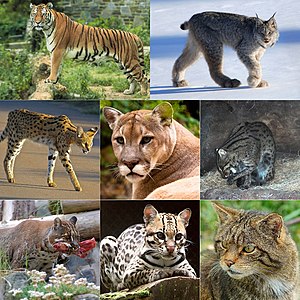Portal:Cats
The Cats PortalFelidae (/ˈfɛlɪdiː/) is the family of mammals in the order Carnivora colloquially referred to as cats. A member of this family is also called a felid (/ˈfiːlɪd/). The term "cat" refers both to felids in general and specifically to the domestic cat (Felis catus). The 41 extant Felidae species exhibit the greatest diversity in fur patterns of all terrestrial carnivores. Cats have retractile claws, slender muscular bodies and strong flexible forelimbs. Their teeth and facial muscles allow for a powerful bite. They are all obligate carnivores, and most are solitary predators ambushing or stalking their prey. Wild cats occur in Africa, Europe, Asia and the Americas. Some wild cat species are adapted to forest and savanna habitats, some to arid environments, and a few also to wetlands and mountainous terrain. Their activity patterns range from nocturnal and crepuscular to diurnal, depending on their preferred prey species. (Full article...) Selected species -The lion (Panthera leo) is a large cat of the genus Panthera, native to Africa and India. It has a muscular, broad-chested body; a short, rounded head; round ears; and a hairy tuft at the end of its tail. It is sexually dimorphic; adult male lions are larger than females and have a prominent mane. It is a social species, forming groups called prides. A lion's pride consists of a few adult males, related females, and cubs. Groups of female lions usually hunt together, preying mostly on large ungulates. The lion is an apex and keystone predator; although some lions scavenge when opportunities occur and have been known to hunt humans, lions typically do not actively seek out and prey on humans. The lion inhabits grasslands, savannahs, and shrublands. It is usually more diurnal than other wild cats, but when persecuted, it adapts to being active at night and at twilight. During the Neolithic period, the lion ranged throughout Africa and Eurasia, from Southeast Europe to India, but it has been reduced to fragmented populations in sub-Saharan Africa and one population in western India. It has been listed as Vulnerable on the IUCN Red List since 1996 because populations in African countries have declined by about 43% since the early 1990s. Lion populations are untenable outside designated protected areas. Although the cause of the decline is not fully understood, habitat loss and conflicts with humans are the greatest causes for concern. (Full article...) List articles
Related portalsWikiProjectsSelected breed -The Siamese cat (Thai: แมวไทย, Maeo Thai; แมวสยาม, Maeo Sayam) is one of the first distinctly recognised breeds of Asian cat. Derived from the Wichianmat landrace, one of several varieties of cats native to Thailand (formerly known as Siam), the original Siamese became one of the most popular breeds in Europe and North America in the 19th century. Siamese cats have a distinctive colourpoint coat, resulting from a temperature-sensitive type of albinism. The carefully refined, more extreme-featured, modern-style Siamese is characterised by blue almond-shaped eyes; a triangular head shape; large ears; an elongated, slender, and muscular body; and various forms of point colouration. Other than point colouration, the modern-style Siamese bears little resemblance to the original foundation stock, and the more moderate, traditional, or "old-style" Siamese, with a much rounder head and body, has been re-established by multiple registries as the Thai cat. Both Siamese and Thai cats are separately selectively bred by breeders, and pedigreed in multiple major cat fancier and breeder organisations. Similar to other officially recognised cat breeds, the term "Siamese" or "Thai" is only meant to be used for cats from this specific breed, which are by definition all purebred cats with a known and formally registered ancestry, also known as the cat's pedigree or "paperwork". (Full article...) Did you know... -
TopicsAssociated WikimediaThe following Wikimedia Foundation sister projects provide more on this subject:
Discover Wikipedia using portals |

























